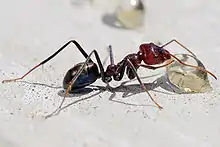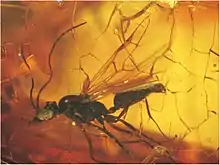Dolichoderinae
Dolichoderinae is a subfamily of ants, which includes species such as the Argentine ant (Linepithema humile), the erratic ant, the odorous house ant, and the cone ant. The subfamily presents a great diversity of species throughout the world, distributed in different biogeographic realms, from the Palearctic, Nearctic, Afrotropical region and Malaysia, to the Middle East, Australian, and Neotropical regions.[2]
| Dolichoderinae | |
|---|---|
 | |
| Iridomyrmex purpureus feeding on honey | |
| Scientific classification | |
| Kingdom: | Animalia |
| Phylum: | Arthropoda |
| Class: | Insecta |
| Order: | Hymenoptera |
| Family: | Formicidae |
| Subfamily: | Dolichoderinae Forel, 1878 |
| Type genus | |
| Dolichoderus Lund, 1831 | |
| Diversity[1] | |
| 48 genera | |
This subfamily is distinguished by having a single petiole (no post-petiole) and a slit-like orifice, from which chemical compounds are released. Dolichoderine ants do not possess a sting, unlike ants in some other subfamilies, such as Ponerinae and Myrmicinae, instead relying on the chemical defensive compounds produced from the anal gland.[3]
Of the compounds produced by dolichoderine ants, several terpenoids were identified including the previously unknown iridomyrmecin, isoiridomyrmecin, and iridodial.[4] Such compounds are responsible for the smell given off by ants of this subfamily when crushed or disturbed.
Tribes and genera
- Bothriomyrmecini Dubovikov, 2005
- Arnoldius Dubovikov, 2005
- Bothriomyrmex Emery, 1869
- Chronoxenus Santschi, 1919
- Loweriella Shattuck, 1992
- Ravavy Fisher, 2009
- Dolichoderini Forel, 1878
- Dolichoderus Lund, 1831
- Leptomyrmecini Emery, 1913
- Anillidris Santschi, 1936
- Anonychomyrma Donisthorpe, 1947
- Azteca Forel, 1878
- †Chronomyrmex McKellar, Glasier & Engel, 2013
- Doleromyrma Forel, 1907
- Dorymyrmex Mayr, 1866
- Forelius Emery, 1888
- Froggattella Forel, 1902
- Gracilidris Wild & Cuezzo, 2006
- Iridomyrmex Mayr, 1862
- Leptomyrmex Mayr, 1862
- Linepithema Mayr, 1866
- Nebothriomyrmex Dubovikov, 2004
- Ochetellus Shattuck, 1992
- Papyrius Shattuck, 1992
- Philidris Shattuck, 1992
- Turneria Forel, 1895
- †Usomyrma Dlussky, Radchenko & Dubovikoff, 2014
- Tapinomini Emery, 1913
- Aptinoma Fisher, 2009
- Axinidris Weber, 1941
- †Ctenobethylus Brues, 1939
- Ecphorella Forel, 1909
- Liometopum Mayr, 1861
- Tapinoma Förster, 1850
- Technomyrmex Mayr, 1872
- incertae sedis
- †Alloiomma Zhang, 1989
- †Asymphylomyrmex Wheeler, 1915
- †Elaeomyrmex Carpenter, 1930
- †Elaphrodites Zhang, 1989
- †Eldermyrmex Heterick & Shattuck, 2011
- †Emplastus Donisthorpe, 1920
- †Eotapinoma Dlussky, 1988
- †Eurymyrmex Zhang, Sun & Zhang, 1994
- †Kotshkorkia Dlussky, 1981
- †Ktunaxia Lapolla & Greenwalt, 2015
- †Leptomyrmula Emery, 1913
- †Miomyrmex Carpenter, 1930
- †Petraeomyrmex Carpenter, 1930
- †Proiridomyrmex Dlussky & Rasnitsyn, 2003
- †Protazteca Carpenter, 1930
- †Yantaromyrmex Dlussky & Dubovikoff, 2013
- †Zherichinius Dlussky, 1988
See also
References
- Bolton, B. (2015). "Dolichoderinae". AntCat. Retrieved 4 January 2015.
- Cardoso, D.; Cristiano, M. P.; Barros, L. S.; Lopes, D.; Pompolo, S. (2012). "First cytogenetic characterization of a species of the arboreal ant genus Azteca Forel, 1978 (Dolichoderinae, Formicidae)". Comparative Cytogenetics. 6 (2): 107. doi:10.3897/CompCytogen.v6i2.2397. PMC 3833797. PMID 24260655.
- Fisher, Brian L. and Stefan P. Cover (2007) Ants of North America: a guide to the genera
- Wilson, E. O.; Pavan, M. (1959). "Glandular Sources and Specificity of Some Chemical Releasers of Social Behavior in Dolichoderine Ants". Psyche: A Journal of Entomology. 66 (4): 70. doi:10.1155/1959/45675.
 This article incorporates text from a scholarly publication published under a copyright license that allows anyone to reuse, revise, remix and redistribute the materials in any form for any purpose: Cardoso, D.; Cristiano, M. P.; Barros, L. S.; Lopes, D.; Pompolo, S. (2012). "First cytogenetic characterization of a species of the arboreal ant genus Azteca Forel, 1978 (Dolichoderinae, Formicidae)". Comparative Cytogenetics. 6 (2): 107. doi:10.3897/CompCytogen.v6i2.2397. PMC 3833797. PMID 24260655. Please check the source for the exact licensing terms.
This article incorporates text from a scholarly publication published under a copyright license that allows anyone to reuse, revise, remix and redistribute the materials in any form for any purpose: Cardoso, D.; Cristiano, M. P.; Barros, L. S.; Lopes, D.; Pompolo, S. (2012). "First cytogenetic characterization of a species of the arboreal ant genus Azteca Forel, 1978 (Dolichoderinae, Formicidae)". Comparative Cytogenetics. 6 (2): 107. doi:10.3897/CompCytogen.v6i2.2397. PMC 3833797. PMID 24260655. Please check the source for the exact licensing terms.
External links
 Media related to Dolichoderinae at Wikimedia Commons
Media related to Dolichoderinae at Wikimedia Commons

